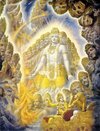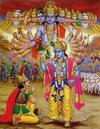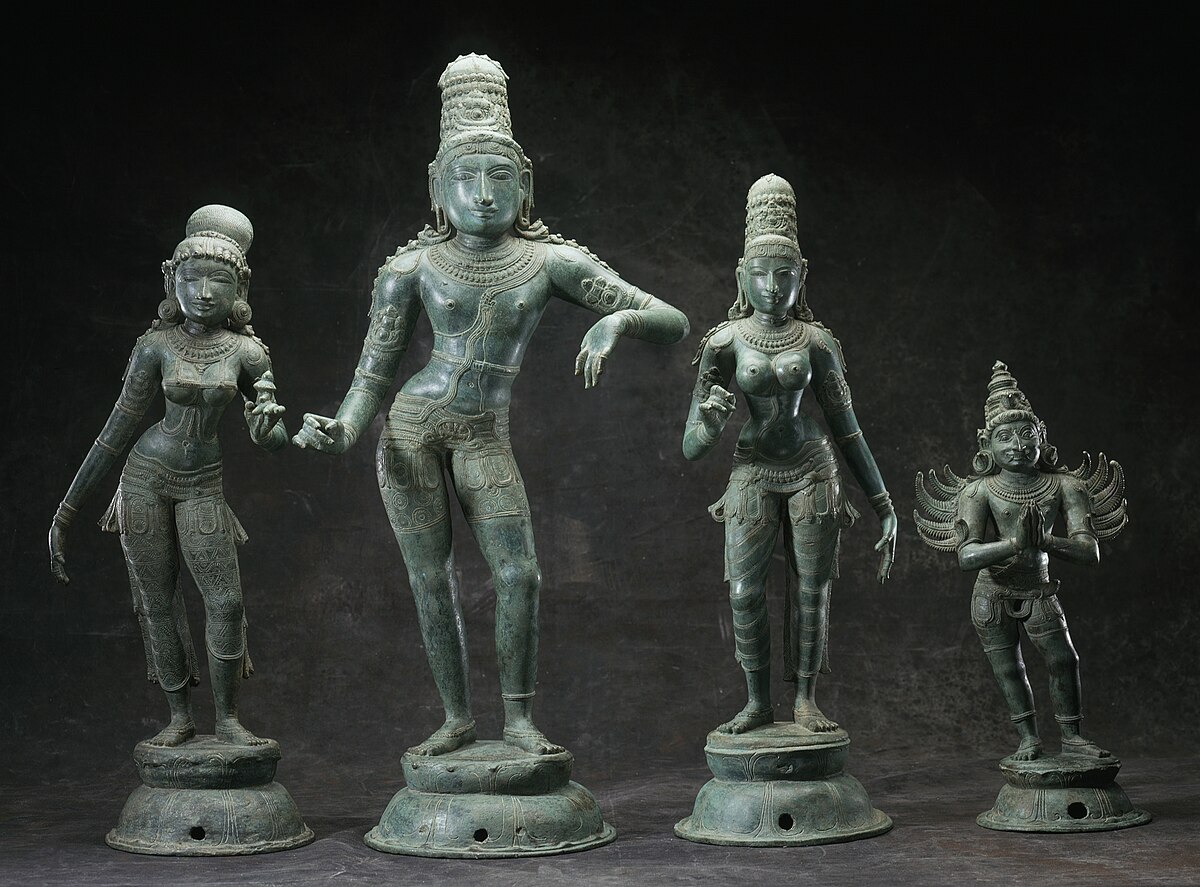2300 BC Volume 3 Page 872
INDIA
The principal followers in Indian mythology are the Maruts. The Maruts are designated as Indra's associates or his troops; he is also said to have generated them [18] called "the lord of the hosts of the Maruts" [19]. Rudra in many places in the literature called the father of Maruts [20]. In Chapter 23, Dyaus has been introduced a representing the heavens. It is said that the Maruts live in Dyaus and are referred to as heroes of Dyaus [20A].
The name Maruts is derived from mr "to shine" [21]. They are particularly linked with lightning. They are brilliant as fire, have spears on their shoulders, and have fiery lightnings in their hands [22]. Three derivations have been offered for the name: ma+ru "which roars in measures", ma+ruc "which shines in measures", mahad+dru "that which runs a great deal". They are said to be suryavarcasah "having the brilliance of the sun" suryatvacah "possessed of sunlike (blazing) bodies, agninam najihva virokinah "brilli like the flames of Agnis (fires) [23]. The name Maruts means "crushers, grinders" [24]
"The Maruts are warriors who are brilliant owing to lightnings, who are armed with weapons of stone...who clothe themselves in a shower of hail" 125]. "They are regarded as fierce and terrible, associated with wrath and evil. They uproot trees and hew the forest; all creatures tremble before them". As in the case of Rudra, they are implored in prayers avert the arrow and stone which they hurl [26]. The following occurs in the Rgveda; "Hitting the world with the flashing weapon of lightning....which burns brightly....they cause the death of men and cattle" [27]; "The great-armed Maruts, with their attacks, injure the enemy with heat as the sky (heats) the earth" [28].
Like Rudra, the Maruts generate sound. In a number of passages, the Maruts are called rudrah "howlers, shouters, roarers" [29]. Again in the Rgveda,
"From the shout of Maruts over the whole space of the earth, men reeled forward" [30];
"they roar like lions "they are great roarers"; they "have the voice in the form of wind" [31]. "They are bright sunshine", "the wonderful and bright Maruts shake the heavens during their onward m which is always accompanied by sound" [32]. There are extensive references earthquakes and ground vibrations.
Hymns to the Maruts abound in words like cyu to “ shake", rej "to shake violently", and vip "to vibrate" [33]. "The earth trembles through fear of their onslaught. It oozes like a shaking and full-loaded boat moving (in water)" [34] "That strength of yours, O Maruts, which causes the people to shake, causes the mountains to shake"; "....the Earth violently shakes like unfirm things, during their marches along their courses" [35], "all regions, the whole universe and the well-built houses on earth shake in great fear as the Maruts march on" [36]. The Maruts are said to dwell in the Asvattha [37], the World-Tree described in detail in Chapter 38.
Another group of followers are the Rakshasos, described in the literature as huge unshapely giants, similar to clouds, with hair and beards of the color of lightning[38]. They frequently—appear as "thunder-clouds wielding bolts", are said to shower stones, are seen to fall from space [39]. The name Rakshasos is linked to "move", "shake dace”, restless" [40] and also to root words meaning to beguarded against”[41]
T
heir leader or father is Ravana, whose name is stated to mean "the yeller", and “Screaming" [42]. Hundreds of thousands of Rakshasos are said to have sprung from the body of Ravana in the fight with Rama [43] in the Mahabharata.
In the Rgveda, "the time The Rakshasos have been into this chapter because of a curious characteristic — their strength is said to reach a peak just after midnight [45]. I have come across an extremely Interesting set of curves, relate to this characteristic. The curves show daily meteor rates as determined by a number of independent sources [46]. Three of curves — visual, backscatter cw radar, and forward-scatter cw radar — show activity between midnight and dawn. The fourth curve — backscatter radar — is the only curve that shows the peak a little after dawn. The curve representing visual sightings is the most important, since the ancient cultures did not have electronic sensing systems and had to rely on the reports of observers. This maximum meteoric activity between midnight and dawn is due to the orbital relationship between Earth and the meteoroid stream. This data then forms a possible link between the Rakshasos and a meteoroid phenomenon. The story is considerably strengthened by the fact that in at least one Indian documentv the Kausika Sutra, a falling meteor is regarded as the embodiment of a Rakshasa [47].
The supernatural qualities of the Yaksas have been the subject of awe, veneration and fear. They were said to assume different shapes at will , make ferocious roars and loud noises — they were considered to be creatures of ill-omen [49]. In the early texts, the Yaksas is derived from the root "yaks", and the meaning of the name Yaksas is "wonderful manifestation or strange apparition or show", "something wonderful or terrible", "supernatural being of exalted character supernatural being revealing himself suddenly" They are derived from root words meaning "to flash, to flirt, to flow quickly or crookedly, to rush hither and thither", "restless, swift, mighty, strong"[50b]. Interestingly, they are closely associated with water, and are described as "reclining on the back of the waters, and are described as reclining on the backs of waters…..like the branches of a tree around the trunk" [51]. They are associated with Rudra [52], which would link them to the Maruts. Agni is called out as leader of the Yaksas [53].
There is also a reference to Murukan and his host [54], as an adjunct to the conflict in Chapter 44.
IRAN
Mithra is attended by the Fravashis who are "numbered by hundreds, thousands and tens of thousands", and who may be another manifestation of a multiple meteoroid fall. The traditions also state that the Fravashis are led by the deity Verethragna [55], which would link them with Ahura Mazda as well as Mithra. The epithets of the Fravashis support the idea of a meteoroid fall — bamya "radiant", uzgerepto-drafsa "possessing banners lifted high", ranjista "most swift", ayo-zaya "possessing metal weapons", urvinyant "crushing", frascandayant "destroying", and xrvisyant "terrible" [56]. "They form many armies, and carry hundreds of weapons; they bear banners, the radiant, who in hot fighting hurriedly descend.." [57]. The appearance of the Fravashis during the event is given by "when the waters burst forth.. ...from the sea Vourakasa and the Ahura Mazda fashioned the hvarnah, then the mighty Fravashis....go forth", "with glistening spears, powerful arrows" [58].
The Fravashis have another characteristic which could be used to identify them with incoming meteoroids. Similar to the Indian Rakshasos, they are commemorated as appearing before dawn [59], corresponding to the actual time of maximum meteor activity. The Fravashis are said to date back to the earliest periods [60]. The name Fravashis originally meant "those who existed before". They became guardian spirits in later Iranian religion through a confusion involving similar sounding words [61].
BRITAIN
Strangely,
the meteoroid-related followers in Irish mythology — the Fomorians. Firbolgs, Tuatha de Danaan and Nemedians — could be the various people that are said to have invaded Ireland at various times. The transformation from mythological to historical personages shows up in their features as well as the features of their leaders.





